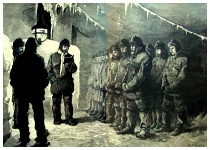
 The Money's Good - If You Live to Spend It Early Arctic exploration was a hazardous business. Aboard the sealed up ships, men lived in filth and died from infectious diseases, or suffered from scurvy as a result of a poor diet. Without modern preservation methods, food soon went bad, and rats ran everywhere. Wooden ships were holed by icebergs, smashed by crushing ice floes, or siezed by the ice and carried off. Men had to endure brutally cold temperatures in unsuitable clothing, and amputated fingers and toes or the scars of frostbite were common. But men signed on for the extra money. British pay for "Discovery Service" was intended to be enough to make a man forget he could well be dead before he earned it. Even the lowest able-bodied seaman could make about three times more than a laborer ashore, and that kind of money was not easily found in Victorian England. As well, there were big cash prizes that would be shared with the crew! The first ship to get through the Arctic to 110° west longitude would get £5,000, £10,000 at 130°, £15,000 at 150°, and £20,000 (equal to over $1 million in today's money) for breaking through to the Pacific Ocean.
Click pictures for more information and credits. Library: Exploration, Boats/Ships, People, Franklin Expedition, Ice, Arctic Links: Northwest Passage, Franklin Expedition, Arctic Northwest Passage Map Arctic Maps & Weather Reports |

|
DICTIONARY: Just "double-click" any unlinked word on this page for the definition from Merriam-Webster's Student Electronic Dictionary at Word Central. |

|
ARCTIC LIBRARY & GLOSSARY: Check this section for an index of the rest of the things you really need to know about the Arctic. |

|
ARCTIC MAPS & WEATHER REPORTS: Maps of the Northwest Passage, explorers' routes, iceberg sources, Nunavut, the Arctic by treeline, temperature... |

|
ARCTIC LINKS: Even more information! Links to sites related to the Arctic and "Iceberg: the Story of the Throps and the Squallhoots". |

|
GUIDE TO ARCTIC SUNRISE & SUNSET: How much sunlight or darkness is there in the Arctic on each day of the year? |
to is the property of their respective owners, and Athropolis is not responsible for their content.